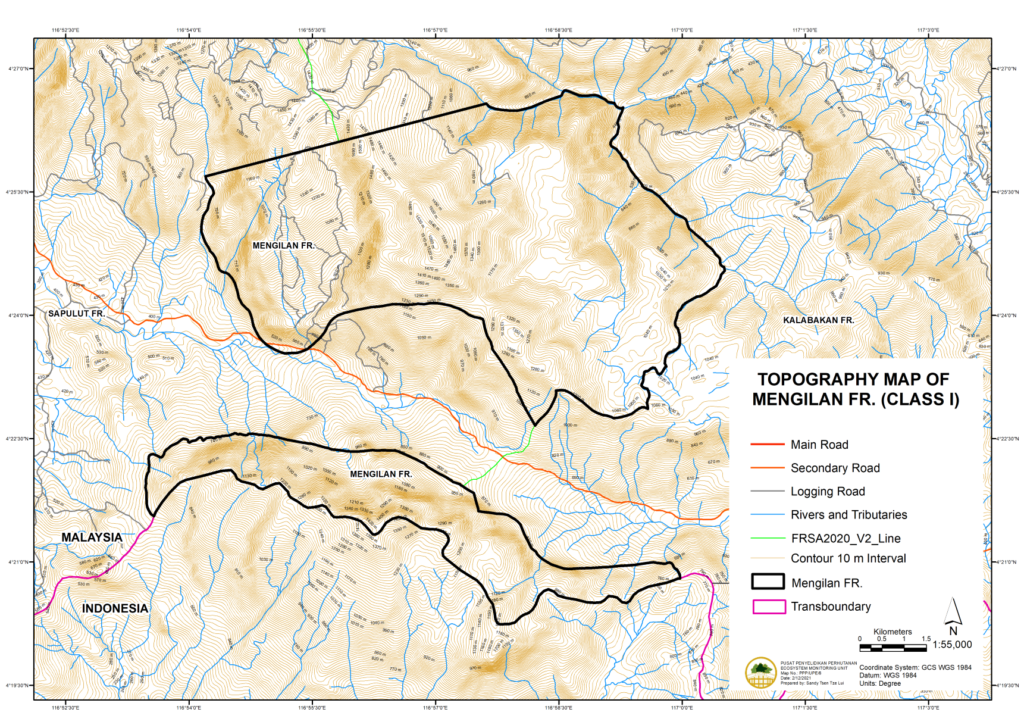CLASS I PROTECTION
6,688.0 ha
Serudong
14.03.1984
115/54
–
None
Protection
Transboundary Wildlife Corridor (Sabah & Kalimantan)
Last updated: 20th June 2022
Mengilan Forest Reserve is a Class I Protection Forest and consists of two units. The forest reserve (FR) is located about 100 km west of Tawau town and situated in between two Class II Production Forest, i.e. Sapulut FR and Kalabakan FR. Its southernmost boundary is also the international border between Sabah, Malaysia and Kalimantan, Indonesia. The reserve is accessible via a junction at 176 km of the Kalabakan-Tawau road and another 30 km drive along heading south.
Latitude/Longitude: Northern unit 4° 22.650′ N-4° 26.700′ N, 116° 54.298′ E-117° 0.682′ E; Southern unit 4° 20.171′ N-4° 22.522′ N, 116° 53.654′ E-117° 0.682′ E
There is no infrastructure within the reserve.
Creations – The reserve was classified as Class I Protection Forest on 29th March 2012. It was formerly gazetted under Kalabakan FR (Class II) and Sapulut FR (Class II). The total area of the reserve is about 6,688 ha.
Management responsibility – Serudong District Forestry Office
Boundary matters – The boundary is yet to be demarcated
Management plan – None
Current Use – Protection
There is no known settlement surrounding the reserve.
Topography

Figure 1: Topography and drainange map of Mengilan FR
Hydrology
River tributaries: no information
Soils
Serudong and Maliau soil associations.
Meteorological data
See Maliau Basin rainfall data.
The original natural vegetation of the reserve consists of the upland mixed dipterocarp-kerangas forest and the lower montane kerangas forest. The former forest ecosystem has the largest extend, covering 61 % of the total area of the reserve. This forest ecosystem usually occurs between 500–900 m asl. The lower montane kerangas forest occurs at a slightly higher elevation between 900–1400 m asl. Unfortunately, past timber extraction activities had resulted in disturbed vegetation of various regenerative stages.
Flora
A total of 763 plant taxa that derived from 122 families were recorded from the reserve and surrounding areas. Of the total taxa, the largest group of plants are represented by the Angiosperms (Monocotyledon, 15 taxa and Dicotyledon 82 taxa); and followed by the ferns (20 taxa); Gymnosperm (3 taxa); and lycophytes (2 taxa). The ten most speciose families in decreasing order are: Dipterocarpaceae(54); Rubiaceae (39); Lauraceae (11); Annonaceae (31); Orchidaceae (27); Fagaceae (26); Melastomataceae (25); Myrtaceae (22); Zingiberaceae (19); and Malvaceae (18). About 175 species in the reserve are bornean endemics and 23 endemic to Sabah.
Threatened species under IUCN Red List:
Taxa under Wildlife Conservation Enactment 1997: –
Schedule 2, part II – (i) Ginger (ii) Palm (iii) Agarwood
Species listed under Appendix II CITES:
Prohibited Species Under Sabah Forest Enactment 1968:
Agathis orbicula, Aquilaria beccariana and Shorea symingtonii are selected as part of the key conservation targets for monitoring biodiversity integrity in Mengilan FR.
Avian
A total of 75 species belonging to 33 families were recorded. The four most species families are Pellorneidae (6), Pycnonotidae (6), Nectariniidar (5) and Cuculidae (5). The most abundant families of Bird species are Apododae, Pycnonotidae, Cisticolidae and Estrilidae.
Of which seven species are Bornean endemic. Namely, i) Black-crowned Pitta, ii) Bornean Black Magpie, iii) Bornean Leafbird, iv) Bornean Necklaced Patridge, v) Dusky Munia, vi) White-crowned Shama, and vii) Yellow-rumped Flowerpecker.
Bornean Necklaced Patridge (VU) was listed as threatened species under IUCN Red List.
Insect
An average of 52 nocturnal insect species from 66 individuals was recorded from a one-metre-square area of the light-trapping cloth. At least eight Bornean endemic species were recorded.
Few records were unable to be identified down to species level.
Mammals
A total of 36 mammals’ species were recorded from this FR. There are 13 species listed as threatened under IUCN Red List.
Wildlife Conservation Enactment 1997: Schedule 1*; Schedule 2**; Schedule 3***
Illegal hunting – Wildlife, probably associated with easy access to the FR.
Enforcement and surveillance – the remoteness of the reserve.
Transboundary wildlife corridor between Southern Sabah and Northern Kalimantan.
FOREST RESEARCH CENTRE
MILE 14, JALAN SEPILOK
P.O.BOX 1407 90715
SANDAKAN SABAH
MALAYSIA
Tel: +6089 531522
Fax: +6089 531068
caims.sabah@gmail.com
The information in this site is intended solely for personal use by a user who accepts full responsibility for its use. While we have taken every precaution to ensure that the content of this site is both current and accurate, errors can occur.
The maps contained in this site should not be used for navigation purposes. In all cases, you should consult Sabah Forestry Department for advice concerning specific matters before making any conclusions related to information obtained from this site.
© 2024 CAIMS Sabah.